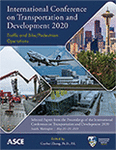International Conference on Transportation and Development 2020
The Impact of Connected Vehicles on Freeway Travel Time
Publication: International Conference on Transportation and Development 2020
ABSTRACT
Connected vehicles (CVs) navigate through multiple routing to select the quickest path. In non-possible multi routing at freeway sections, CVs can make a car platoon to increase the gap between non-CVs. In this study, different traffic conditions, volume levels with four different penetration of CVs have been simulated in PTV Vissim on I-26 in South Carolina. A statistical t-test has been conducted to evaluate the impact of CVs on travel time in different traffic conditions. The results show CVs reduce travel time until 75% penetration when there is no accident on a freeway. Although, with an accident on freeway, the increase in CVs reduces the average speed unless all the vehicles are connected.
Get full access to this article
View all available purchase options and get full access to this chapter.
REFERENCES
Dion, François, Jun-Seok Oh, and Ralph Robinson. 2011. “Virtual Testbed for Assessing Probe Vehicle Data in Intellidrive Systems.” IEEE Transactions on Intelligent Transportation Systems 12 (3): 635–644.
Fagnant, Daniel J., and Kara Kockelman. 2014. “Preparing a Nation for Autonomous Vehicles: 1 Opportunities, Barriers and Policy Recommendations for 2 Capitalizing on Self-Driven Vehicles 3.” Transportation Research 20.
Famili, Afshin, Wayne A. Sarasua, Jennifer H. Ogle, Alireza Shams, and Niloofar Asadi. 2018. “GIS Based Spatial Analysis of Pedestrian Crashes: A Case Study of South Carolina.” In International Conference on Transportation and Development, 368.
FHWA. 2019. “Highway Safety Improvement Program Manual – Safety | Federal Highway Administration.” April 1, 2019. https://safety.fhwa.dot.gov/hsip/resources/fhwasa09029/sec3.cfm.
Haghani, Ali, and Soojung Jung. 2005. “A Dynamic Vehicle Routing Problem with Time-Dependent Travel Times.” Computers & Operations Research 32 (11): 2959–2986.
“How an Automated Car Platoon Works.” 2018. Text. US Department of Transportation. January 11, 2018. https://www.transportation.gov/connections/how-automated-car-platoon-works.
Minelli, Simon, Pedram Izadpanah, and Saiedeh Razavi. 2015. “Evaluation of Connected Vehicle Impact on Mobility and Mode Choice.” Journal of Traffic and Transportation Engineering (English Edition) 2 (5): 301–312.
Narla, Siva RK. 2013. “The Evolution of Connected Vehicle Technology: From Smart Drivers to Smart Cars To… Self-Driving Cars.” Ite Journal 83 (7): 22–26.
Olia, Arash, Hossam Abdelgawad, Baher Abdulhai, and Saiedeh N. Razavi. 2016. “Assessing the Potential Impacts of Connected Vehicles: Mobility, Environmental, and Safety Perspectives.” Journal of Intelligent Transportation Systems 20 (3): 229–243.
Ott, R. Lyman, and Micheal T. Longnecker. 2015. An Introduction to Statistical Methods and Data Analysis. 6th ed. Nelson Education.
PTV Group. n.d. “PTV Vissim.” Accessed April 12, 2019. http://vision-traffic.ptvgroup.com/en-us/products/ptv-vissim/.
Shams, Alireza, and Sunanda Dissanayake. 2014. “Improving Safety at Unsignalized Rural Intersections in Kansas.” T&DI Congress 2014: Planes, Trains, and Automobiles, 356–365.
Shams, Alireza, Sunanda Dissanayake, and Ishani Dias. 2019. “Safety Effects of Bypass Lanes at Rural Two-Lane, Two-Way Unsignalized Intersections.” Journal of Transportation Safety & Security, January, 1–19.
Siegel, Joshua E., Dylan C. Erb, and Sanjay E. Sarma. 2018. “A Survey of the Connected Vehicle Landscape—Architectures, Enabling Technologies, Applications, and Development Areas.” IEEE Transactions on Intelligent Transportation Systems 19 (8): 2391–2406.
Tian, Daxin, Yong Yuan, Jianshan Zhou, Yunpeng Wang, Guangquan Lu, and Haiying Xia. 2013. “Real-Time Vehicle Route Guidance Based on Connected Vehicles.” In 2013 IEEE International Conference on Green Computing and Communications and IEEE Internet of Things and IEEE Cyber, Physical and Social Computing, 1512–1517. IEEE.
USDOT. 2019. “Intelligent Transportation Systems – Connected Vehicle Basics.” 2019. https://www.its.dot.gov/cv_basics/cv_basics_20qs.htm.
Information & Authors
Information
Published In
International Conference on Transportation and Development 2020
Pages: 206 - 214
Editor: Guohui Zhang, Ph.D., University of Hawaii
ISBN (Online): 978-0-7844-8315-2
Copyright
© 2020 American Society of Civil Engineers.
History
Published online: Aug 31, 2020
Published in print: Aug 31, 2020
Authors
Metrics & Citations
Metrics
Citations
Download citation
If you have the appropriate software installed, you can download article citation data to the citation manager of your choice. Simply select your manager software from the list below and click Download.
